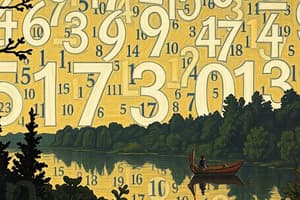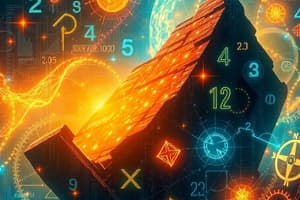Podcast
Questions and Answers
What do measures of central tendency include?
What do measures of central tendency include?
- Mean, median, and mode (correct)
- Probability, statistics, and functions
- Range, variance, and standard deviation
- Sine, cosine, and tangent
Which function graph produces a U-shape?
Which function graph produces a U-shape?
- Logarithmic function
- Linear function
- Exponential function
- Quadratic function (correct)
What is the primary focus of calculus?
What is the primary focus of calculus?
- Studying data distributions
- Analyzing rates of change and accumulation (correct)
- Defining functions and their graphical representations
- Describing relationships in triangles
Which of the following is NOT a common trigonometric function?
Which of the following is NOT a common trigonometric function?
What does dispersion measure in a data set?
What does dispersion measure in a data set?
What type of number includes both positive and negative whole numbers?
What type of number includes both positive and negative whole numbers?
Which operation is performed when finding the total distance traveled by adding individual distances?
Which operation is performed when finding the total distance traveled by adding individual distances?
What is the result of the intersection of two sets?
What is the result of the intersection of two sets?
Which of the following describes a quadratic equation?
Which of the following describes a quadratic equation?
Which term refers to a collection of distinct objects?
Which term refers to a collection of distinct objects?
What type of numbers can be expressed as a fraction p/q, where p and q are integers and q is not zero?
What type of numbers can be expressed as a fraction p/q, where p and q are integers and q is not zero?
What is the term for the distance around a two-dimensional shape?
What is the term for the distance around a two-dimensional shape?
Which unit is typically used to measure weight?
Which unit is typically used to measure weight?
Flashcards
Natural Numbers
Natural Numbers
Positive whole numbers (1, 2, 3, ...)
Set
Set
A collection of distinct objects.
Variable
Variable
A symbol that represents an unknown value.
Equation
Equation
Signup and view all the flashcards
Area
Area
Signup and view all the flashcards
Multiplication
Multiplication
Signup and view all the flashcards
Subtraction
Subtraction
Signup and view all the flashcards
Integer
Integer
Signup and view all the flashcards
Probability
Probability
Signup and view all the flashcards
Central Tendency
Central Tendency
Signup and view all the flashcards
Function
Function
Signup and view all the flashcards
Linear Function
Linear Function
Signup and view all the flashcards
Derivative
Derivative
Signup and view all the flashcards
Study Notes
Basic Arithmetic Operations
- Addition involves combining two or more numbers to find their sum.
- Subtraction involves finding the difference between two numbers.
- Multiplication involves repeated addition of a number.
- Division involves distributing a number into equal parts.
Number Systems
- Natural numbers are positive whole numbers (1, 2, 3, ...).
- Whole numbers include zero and natural numbers (0, 1, 2, 3, ...).
- Integers include positive and negative whole numbers (..., -3, -2, -1, 0, 1, 2, 3, ...).
- Rational numbers are numbers that can be expressed as a fraction p/q, where p and q are integers and q is not zero.
- Irrational numbers are numbers that cannot be expressed as a fraction of two integers.
- Real numbers include all rational and irrational numbers.
Sets
- A set is a collection of distinct objects.
- The empty set is a set with no elements.
- Subsets are sets whose elements are also elements of another set.
- Unions combine elements from two or more sets.
- Intersections find common elements between two or more sets.
- Set operations manipulate sets using union, intersection, and complements.
Algebra
- Variables are symbols that represent unknown values.
- Expressions combine numbers and variables using mathematical operations.
- Equations state that two expressions are equal.
- Inequalities describe relationships where one expression is greater than or less than another.
- Solving equations involves finding the value of the unknown variable.
- Linear equations represent a straight line on a graph.
- Quadratic equations represent a parabola on a graph.
- Polynomials are expressions consisting of variables and coefficients.
Geometry
- Points mark locations in space.
- Lines extend infinitely in two directions.
- Angles are formed by two rays sharing a common endpoint.
- Polygons are closed figures with straight sides.
- Triangles are polygons with three sides.
- Circles are sets of points equidistant from a center point.
- Area measures the amount of space a two-dimensional shape occupies.
- Perimeter measures the total length of the outline of a two-dimensional shape.
- Volume measures the amount of space a three-dimensional shape occupies.
Measurement
- Units of measurement describe the magnitude of a quantity.
- Units for length include meters, centimeters, and kilometers.
- Units for weight include kilograms and grams.
- Units for time include seconds, minutes, and hours.
- Units for area include square meters and square centimeters.
Probability and Statistics
- Probability describes the likelihood of an event occurring.
- Statistics involves collecting, organizing, and interpreting data.
- Mean, median, and mode are measures of central tendency.
- Dispersion measures how spread out data points are.
Functions
- Functions relate input values to output values.
- Graphs visualize functions by plotting input and output pairs on a coordinate plane.
- Linear functions produce straight-line graphs.
- Quadratic functions produce parabola-shaped graphs.
Trigonometry
- Trigonometry deals with the relationships between angles and sides of triangles.
- Trigonometric functions relate angles to ratios of sides.
- Common trigonometric functions include sine, cosine, and tangent.
Calculus
- Calculus deals with rates of change and accumulation.
- Derivatives measure instantaneous rates of change.
- Integrals measure accumulated change.
Studying That Suits You
Use AI to generate personalized quizzes and flashcards to suit your learning preferences.




